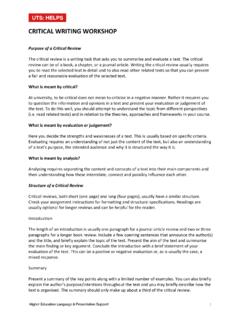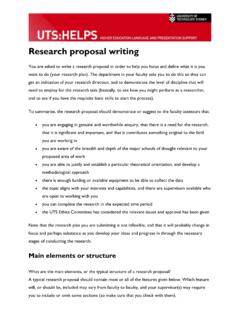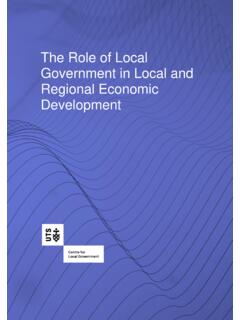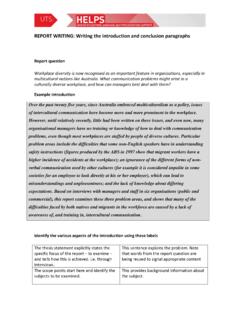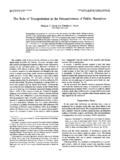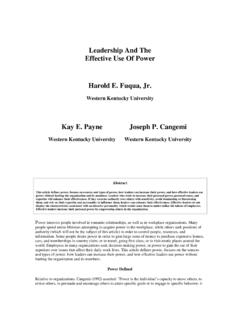Transcription of Seminar presentation - University of Technology Sydney
1 SEMINARPRESENTATION INTENSIVE ACADEMIC PROGRAM UTS: HELPS / JULY 2018 Higher Education Language & presentation Support (HELPS) University of Technology Sydney Building 1, Level 5, Room 25 15 BroadwayUltimo NSW 2007 Australia +61 2 9514 iii Table of contents .. of presentations .. for a presentation .. Purpose .. 8 8 Considerations .. 9 Research and gather information .. 10 Structure .. 11 Resources .. 16 Time management .. 19 20 a presentation .. General tips on making a presentation .. 21 Non-verbal communication .. 22 Verbal communication .. 24 Overcoming nerves .. 29 Handling discussions and the Q&A session .. 32 an effective group presentation .. How to prepare a group presentation .. 38 Giving the presentation .
2 39 Ten tips for improving group presentations .. 39 resources .. 41 Bibliography .. 42 Appendices .. 43 UTS: HELPS / JULY 2017 1 Intensive Academic Program: Seminar presentation Objectives In this workshop, you will learn how to: select relevant information organise material choose a speaking style appropriate to the situation use appreciative language express yourself clearly and audibly use appropriate non-verbal communication when speaking use audiovisual aids to support the presentation deliver an effective presentation contribute to a group presentation deal with difficult situations evaluate your own the end of the workshop, go back to these objectives and self-assess your capabilities. 2 booklet will help you to develop the communication skills and confidence you need to make a presentation .
3 At the end of this program, you should be able to deliver an efficient and effective presentation with confidence. ACTIVITY You can develop your own good presentation habits by observing other people s presentations, both good and bad. Observing bad presentations will help you to avoid getting into some bad habits. What makes a good/bad speaker? Discuss this with the person next to you, and then share your views with the class. A good speaker: A bad speaker: 3 ACTIVITY What makes a good/bad presentation ? Discuss this with the person next to you, and then share your views with the class. A good presentation : A bad presentation : 4 ACTIVITY Introducing a colleague Find someone in the room whom you don t know and interview them. Find out their name, what they are studying and their previous experience in making presentations.
4 If there is time, you might also like to find out their first language or home country, and what they hope to gain from undertaking this intensive course. It is a good idea to write down some facts and to learn how to correctly pronounce the person s name. Introduce this person to the class using a creative introduction such as: Buongiorno, which many of you will know is Italian for hello' or 'greetings , and it is Italy where .. is from .. Or Vietnam, a land of beauty in every way, where .. was born .. Or It is my pleasure to introduce you to someone who is studying something that may one day change how we all live.. is a student of .. Or I am very pleased to introduce you to .. who is currently writing a paper on .. Then, conclude on a positive note and avoid saying something like That s all or I ve finished.
5 Here are some positive suggestions for a conclusion to your introduction: So please welcome .. to our program. Or I m sure we will see and hear more of what .. is writing about in his/her thesis. Or With his/her experience in .., I m certain that .. will be a valuable member of our class. Or I m sure you will see .. around the UTS campus. 5 of presentationsThe prepared presentation The prepared speech is planned and organised before a presentation . You will need to prepare an outline and notes to prompt you. If you use the prompts well, the delivery will appear spontaneous and relaxed. Before making any type of prepared speech, it is important to consider the purpose of your presentation and the audience (more about that later in this book).
6 As you prepare your speech, put important ideas, phrases, quotations and statistics in note form. It is not essential to write down every word of the speech unless you are really nervous. To sound natural, try to add some extra comments when you present your speech. Try not to read the speech word for word you may lose your place, and reading is boring for your audience. If you can speak without reading, you can maintain eye contact with your audience and you can keep an eye on their response to your presentation . Two useful aids are PowerPoint speaker notes and palm cards. The prepared speech is the focus of this program as it is the most common form of presentation in an academic context. PechaKucha 20X20 PechaKucha 20X20 is a simple presentation format where you show 20 images, each for 20 seconds.
7 The images advance automatically and you talk along to the images. (PechaKucha 2014, para. 1)For more information, see: You can also watch past presentations on this site and the presentation of the Day. Giving an introduction Introductions are a part of many academic presentations (Reinhart 2002). We may introduce ourselves or perhaps our fellow students who may all be taking part in the same presentation . You may also be required to introduce a speaker at a Seminar or conference. Making an impromptu speech The impromptu speech is unexpected and is delivered without preparation. Some impromptu speeches are delivered at special occasions, or are courtesy speeches such as welcomes, introductions and acknowledgements. As the occasion for a speech usually takes you by surprise, it is important to think clearly, analyse the situation quickly, and speak briefly and to the point.
8 A way to make these sorts of speeches is to keep to the following order: clearly indicate the reason for the speech explain its relevance to the organisation or audience conclude with some of the characteristics of the individual or organisation receiving recognition. 6 Making a presentation at a team briefing Briefings and oral reports are most often used for staff meetings, customer contacts, and reports to supervisors and managers on progress, results or problems. Whatever the purpose of your briefing, it is often appropriate to give your audience a short memo or written summary. People are more likely to remember communication that combines both spoken and written forms. Making a presentation at a business meeting Speaking at business meetings needs to be very well prepared.
9 You may wish to use PowerPoint or Prezi, but check in advance to see if the necessary equipment is available. You may need to provide your own. You need to know who the audience is, where they work, and what they already know. If you are meeting with an external audience, you will need to have a very well-prepared presentation with a clear opening. End with a clear statement of what you are seeking. Thank them for listening and leave plenty of time for questions. Using a podcast to make a presentation Podcasts supplement conference calls, training courses, briefings and other group communication activities. The shared experience of members of a podcast or blog happens in a virtual world rather than in a shared physical space. You can speak well in a podcast presentation by emphasising common ground in terms of experiences, interest, values and goals between yourself and the audience.
10 Presenting yourself at job interviews Preparation time for this type of presentation may take from two to four weeks. Answer questions in a calm manner. Look at the person who has asked the question, but if it is an interview panel, also look at other members of the panel. When asked if you have any questions, keep them simple and ask about future plans, or internal courses or opportunities for career development. ACTIVITY You will be shown a TED presentation . As you watch the presentation , answer the following questions: do you think is the purpose of this presentation ? is the audience? Do you think the speaker knows the audience? 7 off those qualities as you see them demonstrated in the speaker s presentation : Good, clear carrying voice Confidence Knowledge of subject Well-organised information Eye contact with audience Related to audience s experience Sincerity Enthusiasm Good use of language persuasiveness Good sense of timing Used humour and personal anecdotes Attention-gaining techniques Natural progression of ideas Gauging audience attention Vitality of personality is it that you liked about the presenter?
